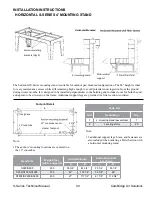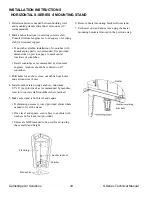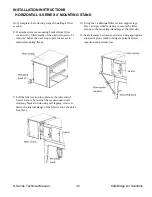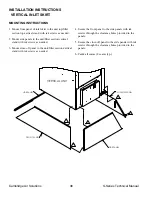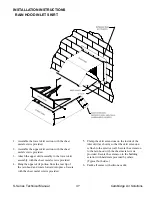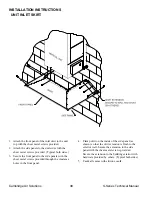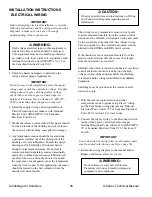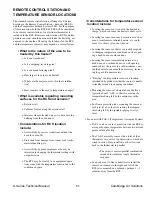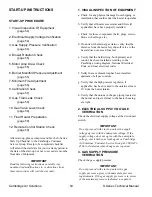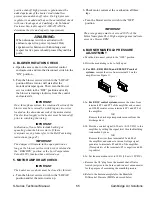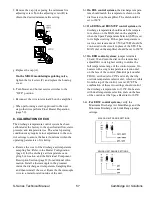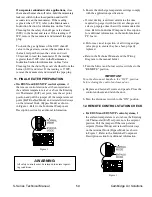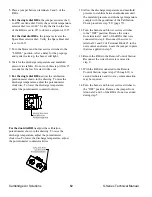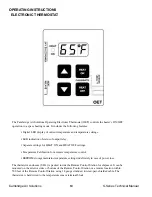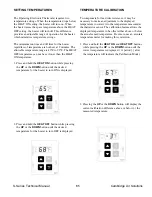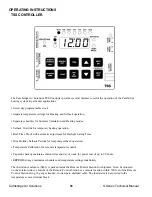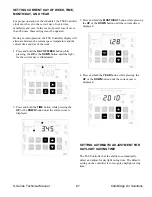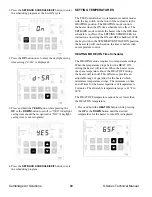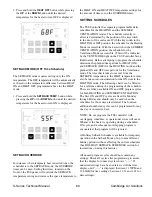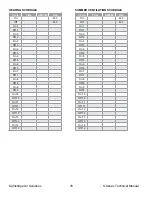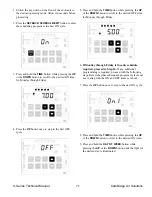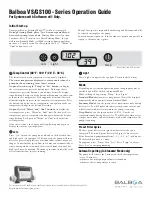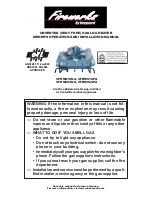
Cambridge Air Solutions
56
S-Series Technical Manual
e. Turn the disconnect switch to the “ON” position.
f. Turn the blower service switch to the “LOCAL” position.
The blower motor will start. Observe the pressure reading
on the manometer and record below. (Note whether the
reading is positive or negative.)
g. Using the formula below, determine the required
manifold pressure reading for the manometer.
Nameplate MDP
_______ " WC
Manifold Static Pressure
(Blower Only) +
_______ " WC
Manifold Pressure Reading = _______ " WC
IMPORTANT
A negative manifold static (blower only) will cause
the manifold pressure reading to be lower than the
nameplate manifold differential pressure.
IMPORTANT
The high limit may trip on warm days. If this oc-
curs allow the high limit to cool. Turn the blower
and burner service switches to the "OFF" position.
Access high limit and manually reset. Close the unit
access doors and turn the blower and burner service
switches to the "LOCAL" position.
h. Turn the burner service switch to the “LOCAL”
position. After a delay for prepurge and igniter
warm-up, the burner will light. Allow 15 seconds
for the low fire start to time out.
i. Observe the manometer reading and compare to the
manifold pressure determined above. If the manifold
pressure reading does not equal this value, adjust the
control regulator until the proper mani-fold pressure
is obtained.
j. Turn the blower and burner service switches to the
“OFF” position.
k. For EDL, EDR, EDSM, and EDSM/TP control
systems, reconnect the wire to terminal #3 on the
amplifier.
For EDSC control systems, remove the 1100 Ω
resistor and reconnect the wires to terminals #T1
and #T2 of the amplifier.
OR
Replace the discharge temperature sensor in the
discharge duct.
If used, remove the signal generator and reconnect
the wires to terminals #5 and #6 of the amplifier
l. When performing a start-up proceed to the next step,
otherwise perform Final Heater Preparation (page
59).
7. MINIMUM FIRE ADJUSTMENT
PROCEDURE
The minimum fire setting is preset at the factory at
approximately 20°F rise. This minimum fire setting
is not critical in space heating applications where the
heater is cycled in response to the space temperature
sensed by an operating thermostat. In this case, the
heater should operate at the maximum discharge tem-
perature, far from the minimum fire setpoint.
IMPORTANT
If a temperature rise of less than 15°F is desired,
a DC microammeter is required to monitor flame
signal during the adjustment procedure. Ensure
the flame current remains steady and of sufficient
strength to maintain burner operation for both con-
sistent ignition at minimum fire and locking in the
flame safeguard relay. Do not allow the flame signal
to drop below 2.0 microamps DC.
a. Turn the blower service switch to the “LOCAL”
position and monitor the discharge temperature.
b. For EDL, EDR, EDSM, and EDSM/TP control
systems, remove the wire from terminal #8 on the
amplifier. This will cause the burner to light on low
fire and then fall to minimum fire.
c. Turn the burner service switch to the “LOCAL”
position. After a delay for prepurge and igniter
warm-up, the burner will light. Allow 15 seconds for
the low fire start to time out.
d. Monitor the discharge temperature. Subtract the
temperature from step "7a" above to determine
the temperature rise. If the minimum fire does not
require adjustment, proceed to step "7h".
e. On the MR212 modulating/regulating valve,
remove the housing cover and loosen the lock screw
(C).


